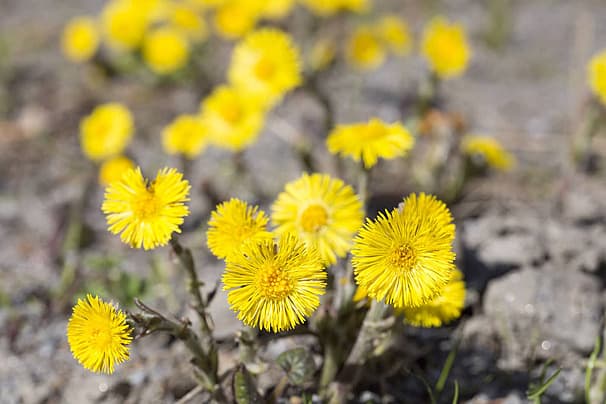
Scientific Name
Tussilago farfara
Common Names
Coltsfoot
Plant Family
Asteraceae
Location
Native to Europe and Asia. Found along roadsides, riverbanks, ditches, and disturbed soils. Introduced in North America. Grows best in moist, clay-rich soils and blooms very early in spring.
Description
Low-growing perennial with dandelion-like yellow flowers that appear before the leaves. Leaves are large, rounded, and felted with a white, woolly underside — said to resemble a colt’s foot. The plant thrives in early spring and fades by midsummer.
Uses
Valued for its respiratory support: it serves as an expectorant and antitussive, helping relieve coughs, bronchitis, asthma, and other upper respiratory tract irritations by loosening and expelling phlegm, soothing inflamed airways, and calming cough reflexes. It exhibits significant anti-inflammatory and antioxidant properties, reducing swelling and oxidative damage in tissues. There is evidence of antimicrobial activity in vitro, with different extracts (ethanolic, aqueous, etc.) inhibiting bacteria and possibly some fungi. The mucilage and soothing leaf and flower infusions also lend demulcent qualities, easing sore throat and irritation of mucous membranes. While not primarily carminative, the general soothing, anti-irritant, and mild digestive calming effects contribute to comfort in some mild digestive upsets or irritation. Thus, the herb is traditionally used where cough, respiratory inflammation, sore throat, or similar irritative states are present, often prepared as teas, syrups, or inhalations.
Energetics
Cooling, moistening, soothing. Targets dryness and irritation, especially in the lungs and throat.
Parts Used
Leaves and flowers (dried)
Constituents
Mucilage, tannins, flavonoids, alkaloids (including pyrrolizidine alkaloids — PAs)
Dosage
- Infusion: 1 tsp dried leaves per cup; steep 10 min
- Tincture (1:5): 20–40 drops, 2–3x/day
Notes on Use
Coltsfoot is excellent for dry, tickling coughs that won’t go away. Use it sparingly and always in short-term, acute situations — because of the concern over PAs. It combines well with marshmallow root, licorice, or mullein for complete respiratory care.
Harvesting
• Harvest young, healthy leaves in early spring, after flowers fade. Dry quickly to avoid mold.
Contraindications
Avoid internal use during pregnancy or for extended periods due to pyrrolizidine alkaloids. Use only with guidance and moderation.
Recipes
- Lung-Soothing Tea: Coltsfoot, licorice, marshmallow
- Respiratory Tincture: Coltsfoot, elecampane, thyme